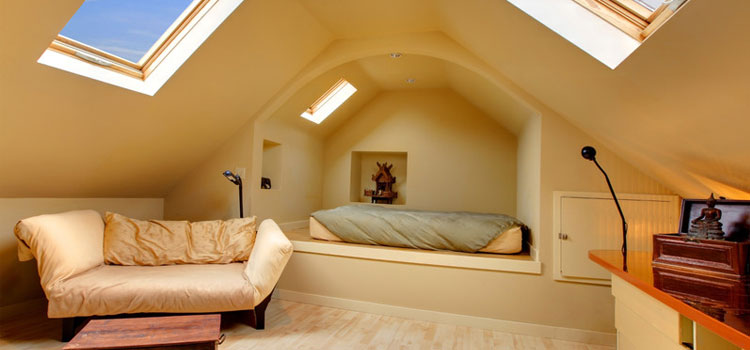
The short answer is YES.In almost all attic conversions steel beams are necessary for supporting the roof. Over the years we have come across attics conversions that customers have asked used to redo because no steel beams were used in the original conversion and as a result, the house roof has sagged in the centre.
The first thing to do when converting an attic or loft is to install RSJ’s (Reinforced Steel Joist).
Reinforced steel joist, these are large steel beams that are installed and anchored into your gable walls in the attic.
Vertical props are then inserted between the rafters and the new beam. These steel beams also carry the new floor joist for the attic, which runs perpendicular to the beams. This means that they carry the weight applied to the attic floor and not the original ceiling joist, which would lead to cracks in the plasterboard ceiling in bedrooms below.
By not installing reinforced steel joists in your attic conversion you will run the risk of a sagging roof as a result.
There will be additional batons fitted to the steel beams to provide support for the roof as well as the structure for the low-rising walls in the new room. The crawl space on the inside of these new rising walls can be used for storage.
A suspended floor is one that is not resting on the ceiling. It has its own separate set of flooring joists. Its function is to support the weight of the attic floor, so it is completely independent of the existing ceiling and it is suspended from the RSJ’s.
Normally the water tank is installed in the centre of the attic. This tank must be moved from this position into the crawl space so that it is out of sight while still accessible. The move involves running new pipes to the new location of the water tank.
Water tanks are typically relocated under the eaves area, with access provided by a hatch. If you have an old metal tank, then it is an ideal time to change it into a plastic one.
Contact Pinnacle Construction today and get a free no obligation quotation for an attic conversion in Dublin.

The easiest way to get an extra bedroom in your home is by getting an attic conversion/loft conversion done. Not particularly disruptive, either, as most of the work can be done from outside. The key thing is to make sure access to the attic/loft is easy and that the conversion fits the rest of the house, rather than looking grafted on. You will have to strengthen the floor joists, which will raise the floor level, so make sure you leave yourself with sufficient ceiling height to stand up in.
The first thing to do before you start dreaming about what to do with the extra room in your home is to see if your attic/loft is suitable for a conversion. Dublin houses often only have space for storage. A good rule of thumb is that over 60% of your attic should have enough room for a large man to stand comfortably without risking a head injury.
A good contractor will see if there is enough room under the house’s roof ridge. The contractor will measure up the attic and the access area to see if it is suitable for a conversion. The contractor will look for rainwater that comes into the attic. If problems are seen, the contractor may repair the roof. Roof repairs will also be needed if you decide to install a dormer window. By adding a roof window it will bring extra light and brighten up the new room.
Reinforced steel joist, these are large steel beams that are installed and anchored into your gable walls in the attic.
Vertical props are then inserted between the rafters and the new beam. These steel beams also carry the new floor joist for the attic, which runs perpendicular to the beams. This means that they carry the weight applied to the attic floor and not the original ceiling joist, which would lead to cracks in the plasterboard ceiling in bedrooms below.
By not installing reinforced steel joist you will run the first of a sagging roof as a result.
Planning permission is not always required when you are doing an attic conversion in Ireland. No planning permission is needed if you are converting the attic for storage but not all attic conversions are used for storage, many people will use them as an extra bedroom.
If you are selling your home you will not be able to count the converted attic as a bedroom unless it has been officially sanctioned by your local county council.
If you are changing the structure of your home by erecting a dormer window or installing a VELUX window to the front of your home, then you will certainly need to apply for planning permission but a VELUX on the back of your house you do not need planning permission.
If you decide to convert your attic/loft, it will give you an extra bedroom or room in your home and it is one of the best ways to increase your home’s value. The process will take some time and money, but the end result will be worth the effort and expense.
Contact Pinnacle Construction today and get a free no obligation quotation for an attic conversion in Dublin.

Home Renovation Scheme Extended
The Home Renovation Scheme will be refunded in the form of a tax credit of 13.5% of the expenditure in the repairs that qualifies. This is then offset against your income over the next two years. The 13.% tax credit effectively negates the Value Added Tax to zero on the qualifying work and it does so up the value of €30,000. The Scheme was introduced back in 2013 and for those interested, to qualify for the Home Renovation Scheme, the renovations to the property must be carried out between October 25th 2013 and 31 December 2018. The extension to 2018 was introduced in Budget 2017.
Home Renovations
Irish Homeowners are back spending money again, with the renovation of their existing homes. Taking advantage of the current grants available to homeowners from the government. One such scheme currently running is the Home Renovation Incentive which was rolled out by the government to kick start the construction industry. Launched by Michael Noonan in Budget 2014, The Home Renovation Incentive Scheme (HRI) offers a window of time in which homeowners can save round 10pc on the construction and up-grading of the their property. work at a time when labour costs for home improvements are at their lowest in 15 years. It was introduced in October 2013 and was taken up by 14,438 properties in 2014 with a total spend of €293m which was released by the revenue commissioners. RTE released an article stating the breakdowns as 37% for home extensions, 22% of claims were for general repairs and renovations and the rest were for windows, kitchen and bathroom refurbishments.
Dubliners accounted for the majority of the works, spending €162.8m.
That was followed by Cork (€29.7m), Kildare (€12.1m), Galway (€10.8m) and Wicklow (€10.1m).
The lowest spend was in Cavan, Longford and Monaghan where 235 works were carried out at a total value of €2.5 million.
The HRI is also available this year and was extended to rental properties in October last.
It has never been a better time to renovate or add some additional space to your home with house prices again on the rise and a shortage of new and existing homes coming to the market. When labour costs for home extensions and improvements are at their lowest in 15 years. Families are choosing to add additional space to their home by extending up or out. With the largest amount of spend within Dublin. It is clear to see that the trend will be that prices will start to increase for trades over the coming years as demand is put back on the trade sector again.
Do i Qualify ?
To qualify for the HRI as an owner-occupier, the work must be carried out on your principal private residence also landlords can qualify in respect of work done on their rental properties. Whether you are a homeowner or a landlord, you have to be up to date on your taxes, i.e. local property tax and house hold charge. You have to be paying income tax either self-employed or PAYE for the HRI scheme. You must only engage with a building contractor to carry out a home extension or other building works if they are VAT (Value Added Tax) in Ireland and are tax compliant. If a number of contactors carry out work on your property and are not under the one contractor you may combine the cost of the total works up to the maximum qualifying grant of €30k before Vat @ 13.5%. (The maximum is €4,050, based on the maximum qualifying expenditure of €30,000) Items that are VAT @ 23% are not cover like architects fees, white goods and furniture. The work that qualifies must cost at least €4,405 before VAT at 13.5%, which adds to a total of €5,000 with VAT included. You will only get the tax credit in relation to a maximum of €30,000 (before VAT) during the 2 years covered by the HRI. (The minimum credit is €595, based on the minimum qualifying expenditure of €4,405) The maximum is €4,050, based on the maximum qualifying expenditure of €30,000.
Types of work that Qualifies
Repair, Improvements and Renovation works and that is charged @ 13.5%
How long do I have to avail of the HRI Scheme
When and how will I receive a rebate on my HRI
Some tips when choosing and working with a contractor to complete your work
Some institutions to look for credit if you are not sitting on a stash of cash is Bank of Ireland they have setup a special €75m fund to lend to homeowners and landlords under HRI. The most likely of the institutions was the Credit Unions which was of course there man bread and butter. But with the hard times we have just gone through they have and a tightness of credit, they have indicated they hope to start lending in this area again. Of course personal loans are available for terms of 10 years and or “top up mortgages ” which would allow borrowing €20,000 over a term of 20 years repaying €125 per month as an example. This would wipe out any saving made with additional repayments close to €10k in the end.

Some helpful tips before you embark on your renovation project
Plan for the bigger picture decide what you need within the property ie the foundations of what you wish to achieve, for example is your plumbing pipework up to standard, your electric system up to standard. Don’t be too worried or thinking of the colours of the walls and floors at this stage. Ask for advice from your builder and see what recommendations they give you. Create a wish list of what you wish to achieve and then broaden the list over time.
When embarking on your project it is important to have people you feel confident in and approachable to deal with as the works continue. You could hire a fantastic tradesman and find that they just continue on with the work regardless without recommending any changes as the project advances. ( it was down on the drawing like this and I just did what it stated on the plans misses) this can cost you a lot of money in the long run to amend if there is a mistake made and not highlighted to you resulting having to knock down a newly build gable wall and rebuilding three feet over.
Check for planning permissions or exemptions
If your home renovation project includes an extension of more than 40sq m, you will need to apply for planning permission. Anything under that may qualify for an exemption, but you should double-check before you begin work. Undertaking work without the correct permission could result in a fine or create problems when it comes to selling your house. Ask your building contractor for advise or if I real doubt seek the advice of an architect. This will cost you additional money but will save you in the long run.
Make sure you have enough money or have secured financing.
Make sure you have secured funding from savings, a bank or credit union prior to starting works. It is advisable to arrange a payment schedule with your builder and have the funds to pay them on time. This will make sure the builder does not feel worried about payment and you will find they will be prepared to go out on limb for you if they are confident they will get paid.
Check to see if you can avail of Government Grants or Incentives
Homeowners may claim up to €4,050 in tax relief on home renovations under the Government’s new Home Renovation Initiative. Under the scheme, you are entitled to reclaim the VAT on projects that cost between €5,000 and €30,000 but you must use a builder who is tax compliant. The Better Energy Homes scheme run by the Sustainable Energy Authority of Ireland, provides grants for roof insulation, wall insulation, boiler and heating control upgrades and solar panels. To qualify for the grant, your house must be built before 2006, you must have the grant approved before work commences and the work must be carried out by one of the authority’s registered contractors. Note that a grant will reduce the level of your tax relief under the Home Renovation Initiative.
Choosing the right builder for you
Get a number of quotes for your works ask friends or work colleagues.
Decide if you can work with the builder and feel they are asking enough questions about your project, do they show enough interest in you to complete the works. Your gut instinct has served you well to date why go against it now.
Make sure your builder is compliant and has a safety system
Ask to see a copy of their public liability and insurance schedule.
Ask are they VAT registered.
Ask are the SEAI and HRI Compliant.
Will you be issued with a certificate of compliance for works on completion.
Ask for a copy of their Health & Safety.
If the project will last more than 30 days you must notify the Health & Safety Authority.
If more than one contractor is on site one must be appointment the Competent Project Supervisor at both the design and construction stage.
A safety file will need to be created for the works and carried on site for the duration of works.